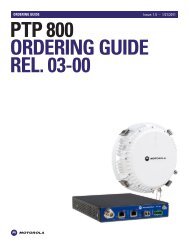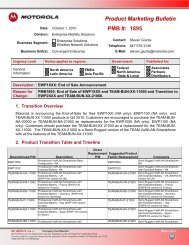Supplement to the Canopy System Release 8 User Guide PMP 400
Supplement to the Canopy System Release 8 User Guide PMP 400
Supplement to the Canopy System Release 8 User Guide PMP 400
You also want an ePaper? Increase the reach of your titles
YUMPU automatically turns print PDFs into web optimized ePapers that Google loves.
<strong>PMP</strong> <strong>400</strong> and PTP 200 Series<strong>Canopy</strong> <strong>User</strong> <strong>Guide</strong> <strong>Supplement</strong>1 IntroductionThis guide provides product description, planning, configuration, and installation informationspecific <strong>to</strong> <strong>the</strong> <strong>PMP</strong> <strong>400</strong> Series networks and PTP 200 Series bridges. It should be used alongwith <strong>the</strong> <strong>Canopy</strong> <strong>System</strong> <strong>Release</strong> 8 <strong>User</strong> <strong>Guide</strong>, which covers general information, including allnetwork features, RF control features, and GUI (Graphical <strong>User</strong> Interface) features commonacross <strong>PMP</strong> 100, 200 and <strong>400</strong> Series networks and PTP 100 and 200 Series bridges. The<strong>Canopy</strong> <strong>System</strong> <strong>Release</strong> 8 <strong>User</strong> <strong>Guide</strong> is available from <strong>the</strong> “<strong>User</strong> <strong>Guide</strong>s” section of <strong>the</strong> <strong>Canopy</strong>Document Library, http://mo<strong>to</strong>rola.canopywireless.com/support/library/?region=1&cat=8.This guide assumes that <strong>the</strong> reader has general RF (Radio Frequency) and Internet Pro<strong>to</strong>col (IP)knowledge and background.This issue, Issue 2, is consistent with features provided by <strong>Canopy</strong> <strong>Release</strong> 8.4.3. Separate<strong>Release</strong> Notes for <strong>Canopy</strong> Software <strong>Release</strong> 8.4.3 are available and include open issues ando<strong>the</strong>r notes.1.1 ABBREVIATIONSThe following abbreviations may be used in <strong>the</strong>se notes:1X2X3XAPBHBHMBHSCMMCNUTDFSEIRPETSIFSKMIBOFDMPtPPtMPQAMQPSKRFSM1X operation, with typical max aggregate (up and down)throughput of 7 Mbps (2 Mbps for 900 MHz)2X operation, with typical max aggregate (up and down)throughput of 14 Mbps (4 Mbps for 900 MHz)3X operation, with typical max aggregate (up and down)throughput of over 20 MbpsAccess Point ModuleBackhaul Module, ei<strong>the</strong>r timing master or timing slaveBackhaul Module – timing masterBackhaul Module – timing slaveCluster Management Module<strong>Canopy</strong> Network Updater ToolDynamic Frequency Selection for radar avoidanceEquivalent Isotropically Radiated PowerEuropean Telecommunications Standards InstituteFrequency Shift KeyingManagement Information Base for SNMPOrthogonal Frequency Division MultiplexingPoint-<strong>to</strong>-Point (Backhauls)Point-<strong>to</strong>-Multi-Point (AP <strong>to</strong> SMs)Quadrature Amplitude ModulationQuadrature Phase Shift KeyingRadio FrequencySubscriber Module1.2 DOCUMENT CHANGE HISTORYIssue 1First IssueIssue 2Significant changes for:Issue 3, January 2009 Page 4 of 45
















